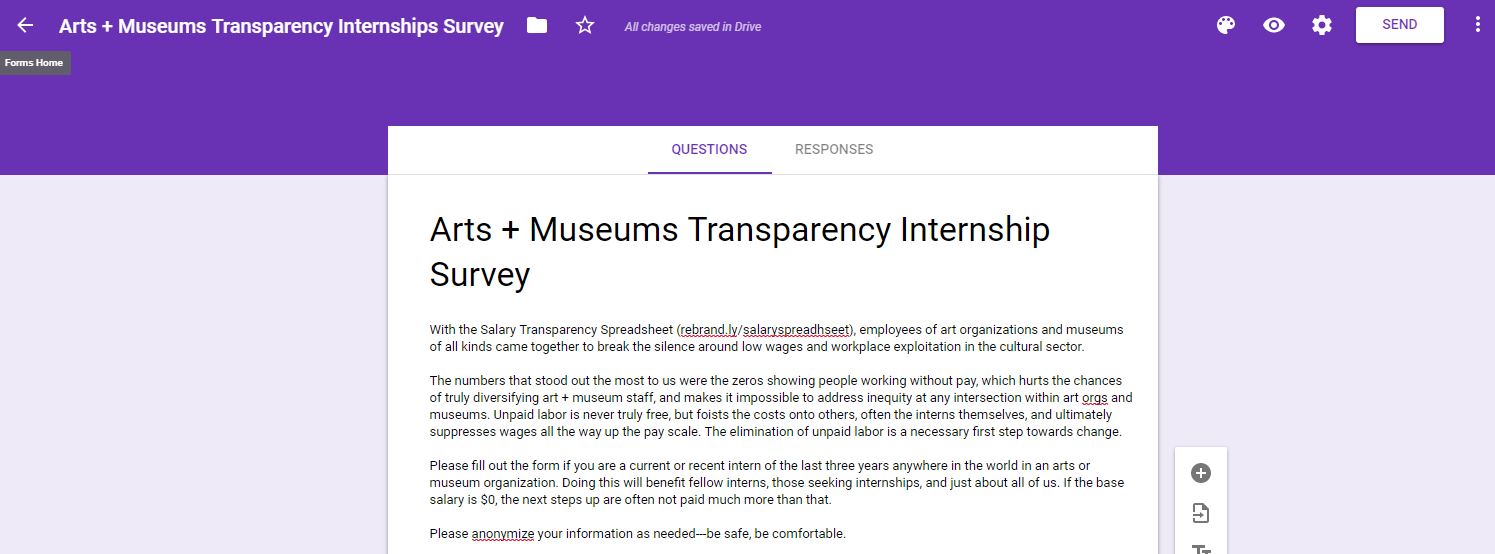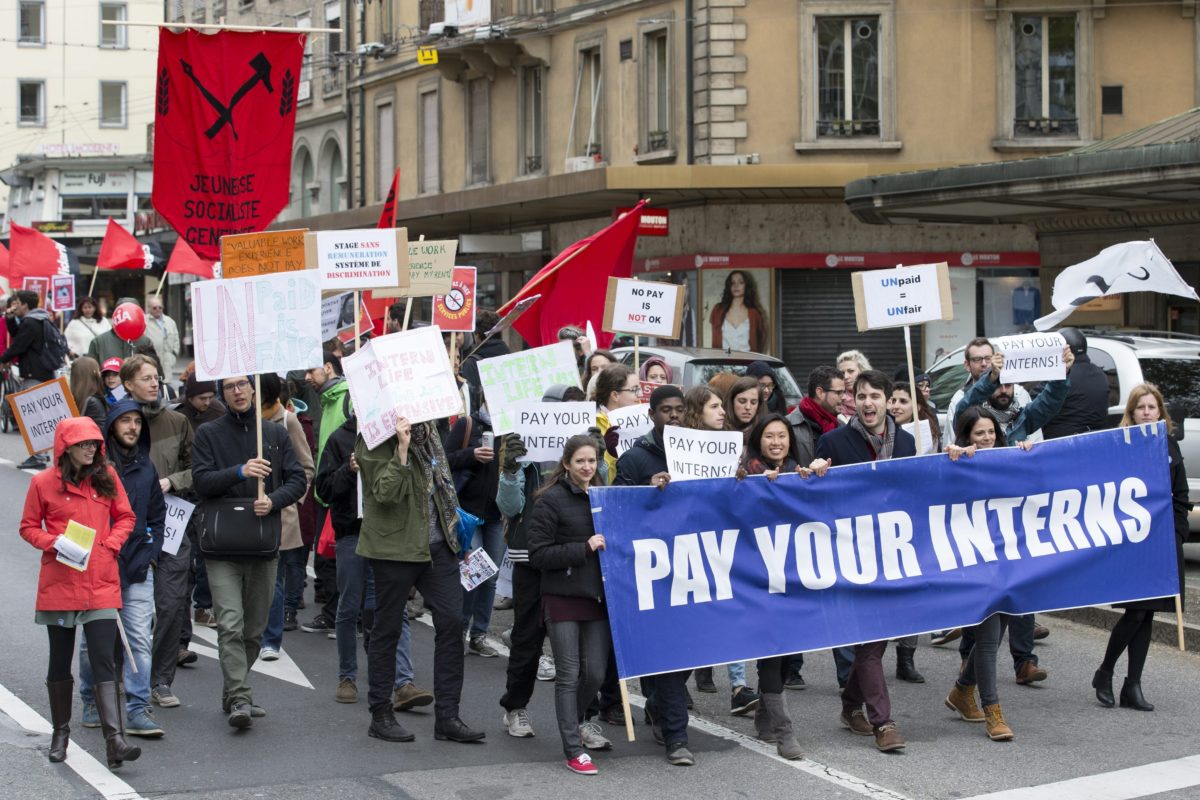[ad_1]

Workers urging employers to pay their interns at a Labor Day demonstration in Geneva in 2016.
SALVATORE DI NOLFI/EPA/SHUTTERSTOCK
Just over a month ago, we started a Google spreadsheet that invited art workers to add their salaries, job titles, and workplaces, as well as additional information as they saw fit. The data was shaped collaboratively and in real time, and it started with only a handful of our own entries. The spreadsheet has now been clicked on over 30,000 times, has almost 3,000 entries, and is still growing.
This document is the product of employees of art organizations and museums of all kinds who came together to break the silence around low wages and workplace exploitation in the cultural sector. It grew because of the work of every single contributor who added in their own details. Some individuals’ work is not reflected in the data, though—for various reasons, some felt that they could not make their salaries public, so they shared the spreadsheet and talked with colleagues about it.
Asked about what comes next, the answer was, for us, very simple. The summer is High Internship Season in many fields. Today we are sharing another spreadsheet focused on this endemic form of unpaid work in museums and arts organizations. The most difficult numbers to read on the “Salary Transparency Spreadsheet” were the zeros entered by people working for free. This is why our next step is to ask for another pooling of knowledge from current and recent interns. If the base salary in our field is $0, then it’s no wonder that the next step up is not much higher. We know what working for free does to the chances of truly diversifying or addressing equity within any intersection of art and museum labor. And yet many of us still support unpaid internships, implicitly and explicitly. Unpaid labor is never truly free. It foists costs onto others, including interns themselves, and ultimately suppresses wages all the way up the pay scale. The elimination of unpaid labor is a necessary first step toward real and lasting change.
Here’s the survey form, and here’s the results spreadsheet. If you are a current intern, or have worked as an intern in the last three years, in an arts or museum organization anywhere in the world, please fill out the form. Anonymize your information as needed—be safe, be comfortable. And suggest changes or critiques—we acknowledge that we are not data specialists and that there is no perfect approach to this topic. One of the many things that the original spreadsheet did not—and, we would argue, could not ever—adequately represent are the shadow resumes, the supportive partners or lack thereof, and the hustle, privilege, and structural dynamics and asymmetries that underpin art-world and museum careers.
In the original spreadsheet, columns were added by participants that requested information about race, gender, and education—information essential for seeing structural inequities, but also data that requires those often marginalized to bear the burden of reporting it. For this reason, we have left race and gender off this current form, but there’s a final question that offers space for any additional details that contributors may want to share.
We are not alone in this endeavor, nor are we the first to call attention to it (though we wrote about it back in 2013). We were heartened to see the excellent news that the Association of Art Museum Directors (AAMD) is calling for an end to unpaid internships. As Jill Medvedow, the director of Boston’s Institute of Contemporary Art and the chair of the AAMD’s Professional Issues Committee, said, “It is obvious that unpaid internships are only available to those who have the means to work without pay. This has been a long-standing practice, but it still needed to be articulated out loud as a first step toward change.”

A screenshot of the Art + Museum Transparency form about unpaid internships.
COURTESY ART + MUSEUM TRANSPARENCY
We want to add one significant update to the resolution, one that we hope the AAMD will adopt. The AAMD resolution allows for unpaid internships in “special circumstances,” including programs that allow students to receive college credit instead of wages. According to the AAMD, “many American schools do not allow students to receive both credit and pay for internships simultaneously.” This is a key example of the complex, interlocking systems that contribute to inequity in our field. Instead of leaving university systems to extract course credit payments from their students, who then pay to work for free in art institutions, we need to stand firm, even if it means transgressing into the lane of higher education. Art workplaces are not discrete from other areas of work and culture like universities and colleges, and we can’t dismiss working for credit as “not our battle.” We cannot accept any form of unpaid labor in our organizations. In fact, many groups essentially ask young people to pay to work for free. This compounds the very inequalities that the otherwise excellent AAMD proposal seeks to dismantle.
The AAMD resolution is non-binding, and it remains focused on museums of art. With the inequities and obstacles it cites, we want to see immediate action. We want this summer’s unpaid internships to be the last of their kind in art museums and organizations. But, even if we move to paid internships today, we must reckon with the barriers that these programs have historically placed on art workers attempting to achieve equitable compensation.
As staff members in this field, we all have differing levels of comfort in our workplaces, and safety is important. But to effect change, please ask yourself which action(s) you can take:
1. Submit your own recent internship experience to the internship transparency spreadsheet, or share the link with current or recent interns you know. Knowledge is power, and data-sharing can effect change.
2. Don’t repost listings for unpaid internships. This includes internships that allow participants to receive college credit. We all know that means students are paying their institutions thousands of dollars to work for free.
3. Don’t benefit from unpaid labor by managing or working alongside unpaid interns. Just say no. Refuse to participate in using the labor of unpaid interns. Do not agree to take unpaid interns in your department. Do not agree to manage them. No matter how good a manager you are, unpaid labor hurts the person undertaking it, along with everyone overseeing them.
4. Pay it forward. If you make enough money, consider donating a percentage of your income to fully or partially fund a needs-based internship, either at your own institution, or via an external program, until our institutions step up.
5. Educate yourself and others on the importance of this conversation for our field. We encourage you to cite the 2018 Andrew W. Mellon Foundation report “Interrogating Institutional Practices in Equity, Diversity, and Inclusion,” which identifies unpaid internships as “functionally exclud[ing] populations that are unable to work for free” and calls on museums to “pay all interns.” Makeba Clay, chief diversity officer at the Philips Collection in Washington, D.C., has written on the “power of a paid internship.” We subscribe to the Fair Museum Jobs UK Manifesto on Internships, which makes a clear and useful distinction between interns and volunteers. We add to their excellent recommendations that:
i. Internships should have an exit reflection between manager and intern to take away key learning outcomes on both sides.
ii. It is not ethical or adequate to change internships to “volunteer” positions to avoid meeting the above standards.
This a very particular moment of change. We stand in solidarity with those who are working hard to make things different—especially around issues of part-time contracts, workplace safety, and lack of benefits—by unionizing (including the Frye Art Museum’s security guards, the Guggenheim Museum’s art handlers, the New Museum’s workers, and others); with Nikki Columbus who has challenged labor discrimination in her landmark case against PS1; with those who are leading the charge by sharing their salaries publicly (Kimberly Drew, who, at the American Alliance of Museums conference earlier this year, publicly shared information about the wages she received); and those who are doing the work of researching and making accessible art world work conditions (the organization POWarts); as well as those who are working in the field for equity of representation of critics and cultural voices (Antwaun Sargent, Elizabeth Méndez Berry, and Chi-hui Yang); and many others doing both highly visible and completely invisible work.
Bringing together data from across the arts and museums (including art, science, children’s, and other museums) across the globe allows us to understand where good opportunities do and don’t occur, and offers a picture of the field today written by those at the very entry level. We invite those who can and wish to participate to join us in making more of the structures of our field visible, making change with our own hands and actions.
[ad_2]
Source link

